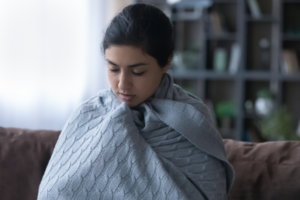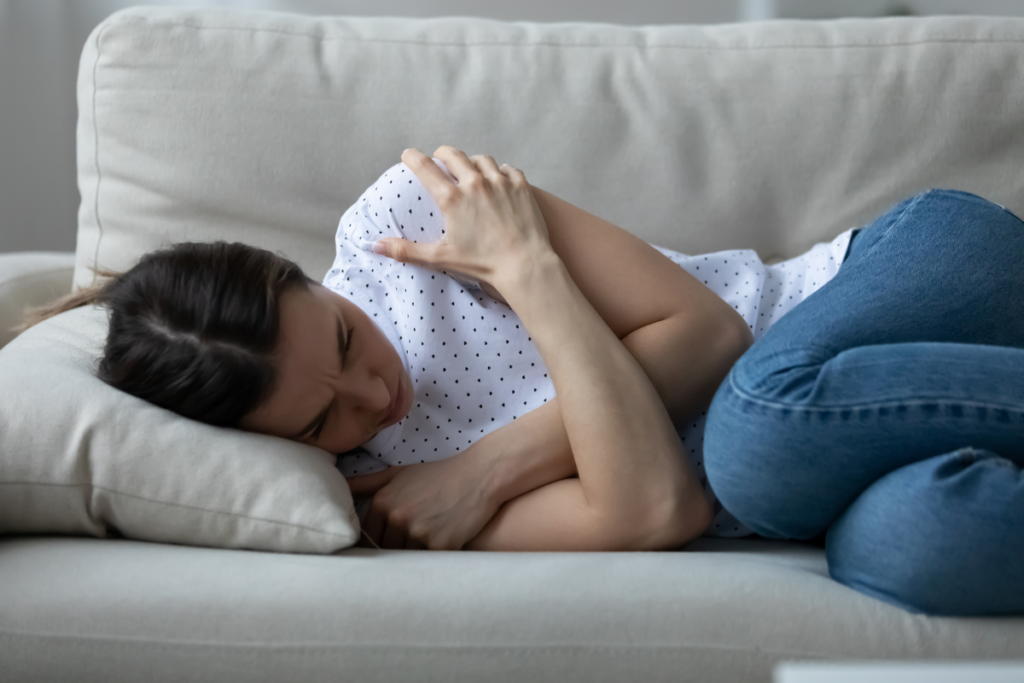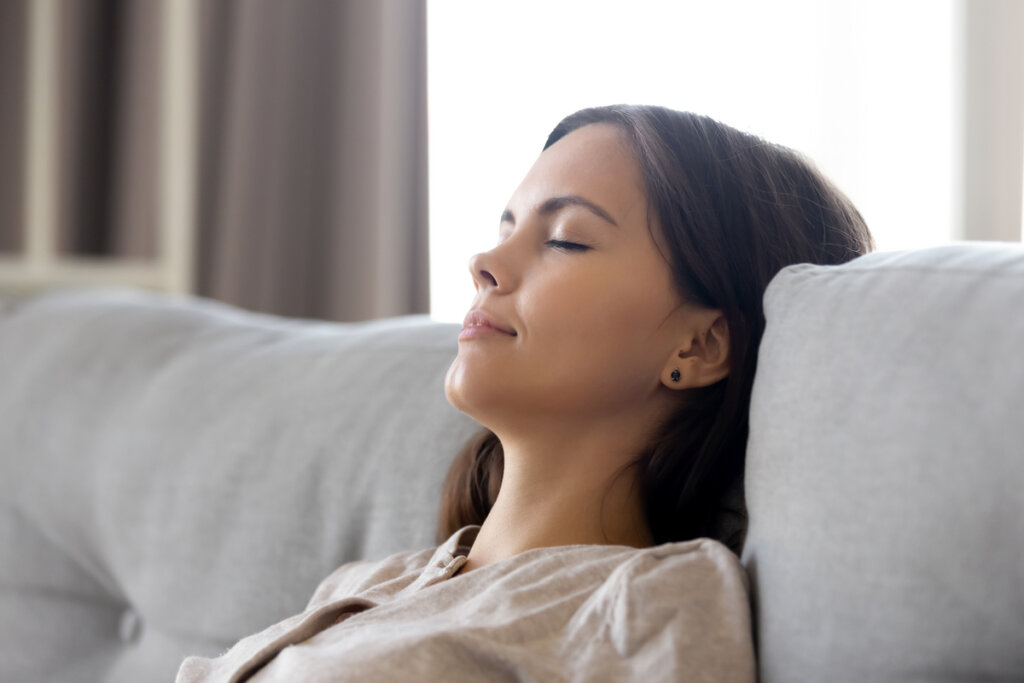Anxiety and Chills

Anxiety is a completely normal physiological, cognitive, and behavioral response under certain circumstances. However, if it becomes frequent, overwhelming, and causes significant clinical distress it can turn into a mental health problem. In fact, the difference between normality and abnormality is a really fine line, whose width depends on the effect of different variables and their interactions.
Among the most significant symptoms of anxiety are nervousness, feelings of imminent danger, insomnia, increased heart rate, tremors, sweating, rapid breathing, and worries. One other symptom that stands out is anxiety chills
Anxiety chills are a recurrent manifestation in situations perceived as threatening. They make anxious people shiver, shake, or feel like it’s hard to regulate their body temperature (Fischer, Haas, & Strahler, 2021).
Anxiety chills usually appear in a high-stress situation, such as during a panic attack. They often occur in parallel with other symptoms of anxiety, whether physical, emotional, or behavioral. Some of their characteristics are as follows:
- Tremors.
- Tingling in the extremities.
- Muscle tension.
- Feeling cold.
- Perception of not having control over the chills.
- Sweating
- Shaking.
- Feelings of suffocation.
As we’ve already mentioned, anxiety is related to chills. However, what’s the exact mechanism by which they’re linked? Why do anxiety chills occur? Let’s take a look.

Causes of anxiety chills
The cause of these chills is found in the fight or flight response that’s activated in a threatening situation. This stress response is an evolutionary reaction that we all have programmed into our brain circuits. Through it, our bodies prepare themselves to protect us from any danger. A problem arises when this reaction is triggered without the presence of real danger.
In these circumstances, the fight or flight response produces a cascade of hormones such as adrenaline or cortisol. This causes physical sensations such as increased heart rate, nausea, stomach pains, shortness of breath, and dilated pupils. These hormones also generate muscle tension, tremors, jerks, and chills.
According to research, when we’re anxious, regulating our body temperature can simultaneously promote or prevent heat loss, leading to feelings of shivering and sweating. The body feels hot during many types of anxiety, although it can feel cold during panic episodes or in the case of specific phobias.
Anxiety chills can also be caused by a freezing response in the body. When this happens, the body calls on a form of physiological arousal, such as shivering, to release built-up tension. It occurs through alterations in blood flow which generate perspiration and sensations of cold that make us shiver. This is why we often experience chills when we’re feeling anxious.
What can be done about anxiety chills?
The key to managing this type of shivering is to treat the general causes or symptoms of the underlying anxiety. For this, it may be useful to learn techniques that allow better management of its physiological manifestations.
Progressive muscle relaxation
Progressive muscle relaxation is an excellent strategy to reduce cortisol (Novais et al., 2016; Dolbier and Rush, 2012). To do this, you must relax all the muscles of your body, group by group. You can start with a few deep breaths to practice. Then, contract and relax each muscle, starting with your forehead and working your way down to your toes.
With time and constant practice, you’ll learn to recognize the tension in your muscles. Consequently, you’ll be able to relax them more easily, thus reducing the physiological reaction of anxiety and its consequent chills.
Diaphragmatic breathing
Diaphragmatic breathing helps lower stress and anxiety levels. In a study that aimed to investigate the effect of diaphragmatic breathing on cognition, affect, and cortisol responses, they found that diaphragmatic breathing can improve attention, affect, and stress levels.
To carry out diaphragmatic breathing, follow this advice.
Get into a comfortable position, close your eyes and watch your breath. Pay attention to its rhythm and depth. Is it deep or shallow? Is it fast or slow? Then, place a hand on your abdomen and make sure that when you breathe you feel how your stomach inflates and deflates with each inhalation and exhalation. Place the other hand on your chest and try not to move it when you breathe. Only the one you have on your abdomen should move.
Breathe in slowly through your nose, so that the hand on your abdomen feels the pressure of it rising. The hand on your chest should remain stationary. Hold your breath for a moment and exhale slowly through your mouth, so that you feel the hand on your abdomen descend.

Mindfulness
Research has found that mindfulness is effective in treating the symptoms of generalized anxiety disorder and can also help control our reactions to stress.
Furthermore, mindfulness has positive psychological effects. For example, increased subjective well-being, reduced psychological symptoms and emotional reactivity, and better regulation of behavior. Through mindfulness, attention is brought to the experience of the here and now with openness, receptivity, and curiosity.
Moving the body
Another strategy for solving anxiety chills is to move. Therefore, doing some type of exercise such as walking, running, jogging, dancing, or jumping can help improve these symptoms.
Finally, the best strategy for putting a stop to anxiety chills is to treat the root problem underlying the anxiety. Hence, the best and most effective option is to seek help from a mental health professional.
All cited sources were thoroughly reviewed by our team to ensure their quality, reliability, currency, and validity. The bibliography of this article was considered reliable and of academic or scientific accuracy.
- Cackovic, C., Nazir, S., & Marwaha, R. (2021). Panic disorder. StatPearls. https://www.ncbi.nlm.nih.gov/books/NBK430973/
- Cleveland Clinic. (2019, 9 de diciembre). What happens to your body during the fight or flight response? https://health.clevelandclinic.org/what-happens-to-your-body-during-the-fight-or-flight-response/
- Dolbier, C. L. y Rush, T. E. (2012). Efficacy of abbreviated progressive muscle relaxation in a high-stress college sample. International Journal of Stress Management, 19(1), 48.
- Fischer, S., Haas, F., & Strahler, J. (2021). A systematic review of thermosensation and thermoregulation in anxiety disorders. Frontiers in physiology, 2167.
- Hoge, E. A., Bui, E., Marques, L., Metcalf, C. A., Morris, L. K., Robinaugh, D. J., … & Simon, N. M. (2013). Randomized controlled trial of mindfulness meditation for generalized anxiety disorder: effects on anxiety and stress reactivity. The Journal of clinical psychiatry, 74(8), 16662.
- Keng, S. L., Smoski, M. J., & Robins, C. J. (2011). Effects of mindfulness on psychological health: A review of empirical studies. Clinical psychology review, 31(6), 1041-1056.
- Sánchez, J. P. y Martínez, J. M. (2009). Reactividad fisiológica periférica y actividad cerebral en las fobias específicas. Escritos de Psicología (Internet), 3(1), 43-54. https://scielo.isciii.es/scielo.php?script=sci_arttext&pid=S1989-38092009000300006
- Ma, X., Yue, Z. Q., Gong, Z. Q., Zhang, H., Duan, N. Y., Shi, Y. T., … & Li, Y. F. (2017). The effect of diaphragmatic breathing on attention, negative affect and stress in healthy adults. Frontiers in psychology, 8, 874.
- Novais, P. G. N., Batista, K. D. M., Grazziano, E. D. S., & Amorim, M. H. C. (2016). The effects of progressive muscular relaxation as a nursing procedure used for those who suffer from stress due to multiple sclerosis. Revista latino-americana de enfermagem, 24.
This text is provided for informational purposes only and does not replace consultation with a professional. If in doubt, consult your specialist.








